View in other NatureServe Network Field Guides
NatureServe
Montana
Utah
Wyoming
Idaho
Wisconsin
British Columbia
South Carolina
Yukon
California
New York
Great Basin Downingia - Downingia laeta
State Rank Reason (see State Rank above)
Rare in Montana, where it is currently known from a few scattered sites in the western half of the state, most of these sites were documented several decades ago and are in need of follow-up surveys. Current population levels and trends are unknown.
- Details on Status Ranking and Review
Population Size
Score2-3 - Very Small to Small: Population size is imprecisely known but is believed to be <10,000 individuals.
CommentPopulation levels are undocumented, but would appear to be very small to small based on the few, available collections.
Range Extent
Score1 - Peripheral, Disjunct or Sporadic Distribution in MT: Widespread species that is peripheral, disjunct or sporadically distributed within MT such that it occurs in <5% of the state (<7,500 sq. miles or the combined area of Beaverhead and Ravalli Counties) or is restricted to 4-5 sub-basins.
Area of Occupancy
Score2 - Low: Generally occurring in 4-10 Subwatersheds (6th Code HUC’s).
Environmental Specificity
Score1 - Moderate: Species is restricted to a specific habitat that is more widely distributed or to several restricted habitats and is typically dependent upon relatively unaltered, good-quality habitat (C Values of 5-7).
Trends
Score0-3 - Population trends are unknown.
Threats
Score0-1 - Low to Medium.
Intrinsic Vulnerability
Score1 - Moderate Vulnerability: Specific biological attributes, unusual life history characteristics or limited reproductive potential makes the species susceptible to extirpation from stochastic events or other adverse impacts to its habitat and slow to recover.
Raw Conservation Status Score
Score
7 to 12 total points scored out of a possible 19.
General Description
Great Basin Downingia is a glabrous annual with simple or branched stems that can be up to 20 cm tall. The sessile, lance-shaped leaves are 5-20 mm long, and the lower wither early. The stalkless flowers are borne in the axils of the smaller upper leaves, or bracts. The flower is borne on top of the slender ovary, which may appear to be a thickened stalk. The inconspicuous, blue-marked-with-yellow corolla is 4-7 mm long and has a 2-lobed upper lip and a 3-lobed lower lip. The calyx has 5 linear lobes that are 3-8 mm long and as long or longer than the corolla. The stamens are united into a column. The many-seeded capsule is 20-45 mm long and 1-2 mm thick.
Phenology
Flowering in June-early July, fruiting July-early October.
Diagnostic Characteristics
The 2-lipped corolla is as long as the calyx and is mounted on the long slender ovary; both this facet and the fruit are distinctive. Howellia aquatilis has 2-4 seeds per capsule. The asymmetry between the 2-lobed upper and the 3-lobed lower lip in combination with the elongate capsule distinguish it from most other wetland genera and families.
Species Range
Montana Range
Range Descriptions
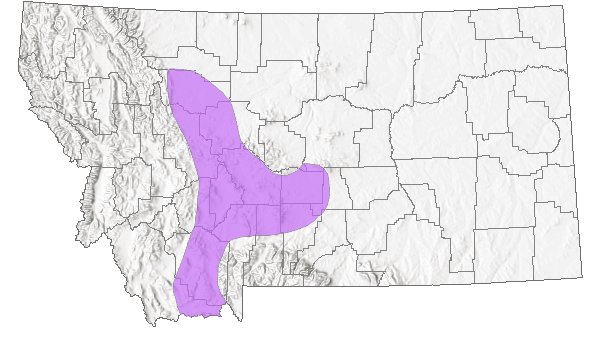
 Native
Native
Range Comments
Soutnern AB and western MT to eastern OR, northern CA, and central NV to southern WY.
Observations in Montana Natural Heritage Program Database
Number of Observations: 16
(Click on the following maps and charts to see full sized version)
Map Help and Descriptions
Relative Density
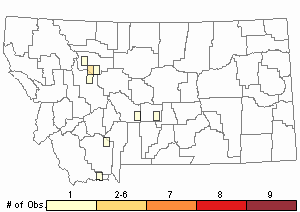
Recency
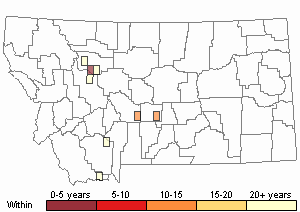

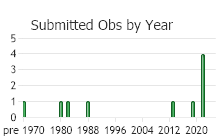
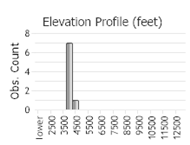 (Observations spanning multiple months or years are excluded from time charts)
(Observations spanning multiple months or years are excluded from time charts)
Habitat
Shallow water and drying mud around ponds and lakes in the valleys and on the plains.
National Vegetation Classification System Groups Associated with this Species
Wetland and Riparian
Alkaline - Saline Wetlands
Wet Meadow and Marsh
Stewardship Responsibility
Threats or Limiting Factors
STATE THREAT SCORE REASON
Threat impact not assigned because threats are not documented. (MTNHP Threat Assessment 2021).
References
- Literature Cited AboveLegend:
 View Online Publication
View Online Publication MTNHP Threat Assessment. 2021. State Threat Score Assignment and Assessment of Reported Threats from 2006 to 2021 for State-listed Vascular Plants. Botany Program, Montana Natural Heritage Program, Helena, Montana.
MTNHP Threat Assessment. 2021. State Threat Score Assignment and Assessment of Reported Threats from 2006 to 2021 for State-listed Vascular Plants. Botany Program, Montana Natural Heritage Program, Helena, Montana.
- Additional ReferencesLegend:
 View Online Publication
View Online Publication
Do you know of a citation we're missing? Culver, D.R. 1994. Floristic analysis of the Centennial Region, Montana. M.Sc. Thesis. Montana State University, Bozeman. 199 pp.
Culver, D.R. 1994. Floristic analysis of the Centennial Region, Montana. M.Sc. Thesis. Montana State University, Bozeman. 199 pp. Lesica, P. 1991. The Rare Vascular Plants of Pine Butte Swamp Preserve. Unpublished Report to the Nature Conservancy. 15 Pp.
Lesica, P. 1991. The Rare Vascular Plants of Pine Butte Swamp Preserve. Unpublished Report to the Nature Conservancy. 15 Pp. Lesica, P., M.T. Lavin, and P.F. Stickney. 2012. Manual of Montana Vascular Plants. Fort Worth, TX: BRIT Press. viii + 771 p.
Lesica, P., M.T. Lavin, and P.F. Stickney. 2012. Manual of Montana Vascular Plants. Fort Worth, TX: BRIT Press. viii + 771 p. Lesica, P., M.T. Lavin, and P.F. Stickney. 2022. Manual of Montana Vascular Plants, Second Edition. Fort Worth, TX: BRIT Press. viii + 779 p.
Lesica, P., M.T. Lavin, and P.F. Stickney. 2022. Manual of Montana Vascular Plants, Second Edition. Fort Worth, TX: BRIT Press. viii + 779 p.
- Web Search Engines for Articles on "Great Basin Downingia"





